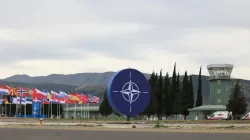Why did Sweden join NATO even though Putin warned of harsh ramifications?
Sweden has stayed out of military alliances for more than 200 years and long ruled out seeking NATO membership. But after Russia’s full-scale invasion of Ukraine in February 2022, it ditched its longstanding policy of nonalignment almost overnight and decided to apply to join the alliance.

Washington: Sweden on Thursday formally joined NATO as the 32nd member of the transatlantic military alliance, ending decades of post-World War II neutrality as concerns about Russian aggression in Europe have spiked following Russia’s 2022 invasion of Ukraine.
Swedish Prime Minister Ulf Kristersson and Secretary of State Antony Blinken presided at a ceremony in which Sweden’s “instrument of accession” to the alliance was officially deposited at the State Department. “This is a historic moment for Sweden. It’s historic for the alliance. It’s historic for the transatlantic relationship,” Blinken said. “Our NATO alliance is now stronger, larger than it’s ever been.”
What is NATO and why Sweden seeks NATO membership?
Sweden has stayed out of military alliances for more than 200 years and long ruled out seeking NATO membership. But after Russia’s full-scale invasion of Ukraine in February 2022, it ditched its longstanding policy of nonalignment almost overnight and decided to apply to join the alliance together with neighbouring Finland.
Both Sweden and Finland, which joined the military alliance last year, had already developed strong ties with NATO after the end of the Cold War, but public opinion remained firmly against full membership until the war in Ukraine. Nonalignment was seen as the best way to avoid tensions with Russia, their powerful neighbour in the Baltic Sea region. But the Russian aggression caused a dramatic shift in both countries, with polls showing a surge in support for NATO membership.
Political parties in both Finland and Sweden decided they needed the security guarantees that only come with full membership in the U.S.-led alliance.
Why did it take so long?
While Finland became NATO’s 31st member in April, Sweden’s application has been held up. All alliance members but Turkey and Hungary gave their thumbs up. On January 23, Turkish legislators voted in favor of Sweden’s membership in NATO. To let Sweden join, Turkish President Recep Tayyip Erdogan put forth a series of conditions including a tougher stance toward groups that Turkey regards as threats to its security, such as Kurdish militants and members of a network it blames for a failed coup in 2016.
Although the Swedish government tried to appease Erdogan by lifting an arms embargo on Turkey and promising to cooperate on fighting terrorism, public demonstrations in Sweden by supporters of the outlawed Kurdistan Workers’ Party, or PKK, and by anti-Muslim activists who burned the Quran complicated the situation.
Pressure from the U.S. and other NATO allies on Turkey to remove its objections to Swedish membership appeared to have little effect until Erdogan said at a NATO summit last year that he would send the documents to Parliament for approval. But the issue was held up in Parliament until lawmakers finally held a vote on the issue and ratified Sweden’s accession protocol. The Turkish government finalized the step by publishing the measure in an official gazette.
The parliament in Hungary has ratified Sweden’s bid to join NATO, bringing an end to more than 18 months of delays by the nationalist government.
Initially, Hungary didn’t give any clear reason for its delays and Prime Minister Viktor Orbán long insisted that his country wouldn’t be the last to give approval. But the tone toward Stockholm hardened last year, with Hungary accusing Swedish politicians of telling “blatant lies” about the condition of Hungary’s democracy. Orbán has broken ranks with NATO allies by adopting a Kremlin-friendly stance toward Russia’s invasion of Ukraine.
What would Sweden bring to the NATO alliance?
The inclusion of Sweden would leave the Baltic Sea almost surrounded by NATO countries, strengthening the alliance in the strategically important region. The Baltic Sea is Russia’s maritime point of access to the city of St. Petersburg and the Kaliningrad enclave.
Sweden’s armed forces, though sharply downsized since the Cold War, are widely seen as a potential boost to NATO’s collective defense in the region. The Swedes have a modern air force and navy and have committed to increasing defence spending to reach NATO’s target of 2% of gross domestic product.
Like the Finns, Swedish forces have for years participated in joint exercises with NATO.
How Russia has reacted?
Not surprisingly, Moscow reacted negatively to Sweden and Finland’s decision to abandon nonalignment and seek NATO membership and warned of unspecified countermeasures. Russia said the move adversely affected the security situation in Northern Europe, which it said ”had previously been one of the most stable regions in the world.”
Earlier this year, Sweden’s top military commander Gen. Micael Bydén said all Swedes should mentally prepare for the possibility of war, and on Feb. 19, Thomas Nilsson, head of Sweden’s external intelligence service, MUST, said that “the situation has continued to deteriorate during 2023.”
“In the event of NATO membership, we must have the capability through an alliance to counter a revanchist and unpredictable Russia,” the agency said in its assessment. Both Sweden and Finland have warned of an increased risk of Russian interference and hybrid attacks.
(With inputs from agency)
